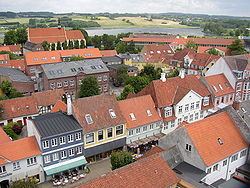Time zone CET (UTC+1) Local time Saturday 10:57 PM | Population 7,178 (2014) | |
 | ||
Weather 2°C, Wind SE at 13 km/h, 91% Humidity Municipality Faaborg-Midtfyn Municipality Points of interest Faaborg Museum, The Belfry Faaborg, Øhavsmuseet, Svanninge Bakker, Konservesgaarden | ||
Yogalayam faaborg denmark
Faaborg or Fåborg ([ˈfʌb̥ɒːˀ]) is an old port town located on Faaborg Fjord in Faaborg-Midtfyn municipality on the island of Funen in Denmark. By road, Faaborg is located 42 kilometres (26 mi) southwest of Odense, 27 kilometres (17 mi) north-northwest of Svendborg, and roughly 70 kilometres (43 mi) southeast of Middelfart, depending upon the route. It has a population of 7,178 (1 January 2014). With its busy port, narrow streets and attractive old houses, the town is popular with tourists, particularly in the summer months. Faaborg was formerly the seat of Faaborg municipality. The seat of the new municipality is Ringe. Both municipalities use(d) Faaborg's medieval coat of arms.
Contents
- Yogalayam faaborg denmark
- Map of 5600 Faaborg Denmark
- History
- Landmarks
- Transport
- Notable people
- References
Map of 5600 Faaborg, Denmark
History
Faaborg is first mentioned as Foburgh in a document located in the French National Archives in Paris dated 25 June 1229. It is a deed of gift that gives Faaborg and the south of Funen as a morning present to Eleanor of Portugal, from Valdemar II to his daughter-in-law. It is mentioned as a castle (Foburgh meaning Fox Castle), so it must have existed before this date. However, this date has been used as the birth date of Faaborg and thus the town celebrated its 775th anniversary in 2004.
Although it is not known when the settlement was established, it appears Faaborg had already received privileges as a market town in the 13th century. Located on a promontory surrounded by water on three sides, the site was further protected by a moat and a town wall. Around 1477, a monastery was established which over the years acquired most of the property in the town and its surroundings. After the Reformation it was used for a time as a hospital until it was finally demolished. The monastery chapel became the parish church.
In the 16th and 17th centuries, Faaborg had to compete with a considerable amount of illegal trading from other settlements along the coast. In the mid-17th century, it suffered even more from the effects of the Swedish Wars but it began to prosper as an important port in the 18th century. Corn was exported to Norway and trade increased with the Grand Duchies of Schleswig and Holstein. By the 1890s, ships from Faaborg sailed as far as the Mediterranean. In the 19th century, England replaced Norway as the main trading partner and, in the second half of the century, trade extended to China and Australia. By the end of the century, there had been a huge increase in population (from 1,000 to 4,000) and a number of light industries had been established. Many of the new inhabitants came from Schleswig and Holstein after these had been lost to Germany. They included many Jews who made Faaborg Funen's most Jewish community with its own synagogue. With 50 employees, Dansk Vin- og Konservesfabrik (wine and canning) was the main business but traditional crafts and trading continued while the harbour was also enlarged. Steamship links with Copenhagen and Southern Jutland were established and in the 1880s railway connections were ensured with the other towns on the island.
Growth was more modest in the 20th century in the face of competition from Odense and Svendborg. A few new industries emerged in food processing and metal working but tourism and services became the leading areas of growth. By 2007, Faaborg had 7,318 inhabitants.
Landmarks
The harbour, old streets, historic mansions and town houses all make Faaborg a pleasant city for visitors. Its many restaurants serve a wide variety of Danish and foreign dishes. Plougs Gård on Vestergade, built around 1790, is one of the finest buildings in the town with its Neoclassical facade. Jesper Ploug made his fortune in shipping during the American Wars of Independence (1776—1783)
Faaborg Church (Helligåndskirken) is an old monastery church dating from 1477. It formed the south wing of the now demolished Helligåndskloster belonging to the Order of the Holy Ghost from which it gets its name. Its considerable size makes it a local landmark: 46 m (151 ft) long by 19 m (62 ft) wide. The chancel and three-sided east gable were completed in 1490, the nave and southern aisle followed around 1510 and a northern aisle was added shortly thereafter. After its vaulting in 1681, it resembled a basilica. Restoration work was carried out in 1858 and 1902. The church has no tower but the tower of the now demolished Saint Nicholas Church (1450) serves as its belfry.
Faaborg Museum holds one of Denmark's most important art collections with works by the Funen Painters including Jens Birkholm, Peter Hansen, Johannes Larsen, and Anna and Fritz Syberg. It also displays some of the finest works of sculptor Kai Nielsen. Den gamle Gård on Holkegade provides insights into the town's cultural history, with exhibits depicting life in the 18th and 19th centuries.
Faaborg Harbour, with its centrally placed marina, attracts about 13,000 pleasure boats each year thanks to its attractive location for the South Funen Archipelago. It is frequently visited by vintage schooners and yachts of all sizes. The port is also used by fishing boats and commercial vessels.
A new waterpark, Faaborg Harbor Bath, was completed in 2014.
Nearby attractions include Egeskov Castle, Hvedholm Castle and Horne Church.
Transport
Faaborg Rutebilstation, a former railway station built in 1882, now serves as a bus station for FynBus. There are regular ferry links from Faaborg to the islands of Bjørnø, Lyø, Avernakø and Ærø.
Notable people
Faaborg is closely associated with the Funen Painters (Fynboerne) including:
Other notables include:
